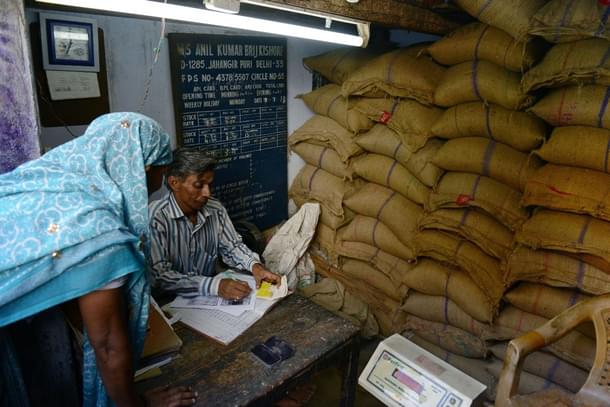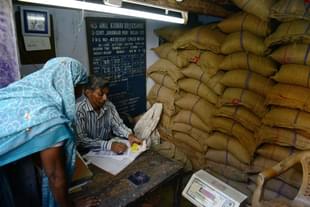Economy
Amber Signals Are Flashing For India: Time To Mind The Fisc, Reduce Food Subsidies
R Jagannathan
Sep 30, 2022, 11:28 AM | Updated 11:27 AM IST
Save & read from anywhere!
Bookmark stories for easy access on any device or the Swarajya app.


India needs to be more conservative in its economic policies now.
Sure, among major economies, we are the only game in town.
Our inflation levels are still below that of the developed western world, and interest rates are still moderate despite precautionary action by the Reserve Bank of India (RBI).
In Friday’s policy review, the Monetary Policy Committee has raised repo rates by 50 basis points to 5.9 per cent, in keeping with the need to tame retail inflation, and also in anticipation of more aggressive moves by the US Federal Reserve, the European Central Bank and the Bank of Japan in the coming months.
Clearly, warning signals for India are flashing amber.
The first quarter current account deficit (CAD) for fiscal 2022-23, at 2.8 per cent, is close to the psychologically important 3 per cent limit that is considered sustainable.
Our currency is depreciating, thanks not to our own follies, but Western ones and the market’s infinite ability to overprice the dollar.
Despite reasonably high foreign exchange reserves, the Reserve Bank cannot endlessly sell dollars to reduce volatility.
It will have to let the market determine rupee rates, and this means imported inflation will be higher, impacting growth.
Worse, we should worry about election season too.
With the BJP government focused on the Gujarat elections in the next quarter, it has continued the free grain scheme under the Pradhan Mantri Garib Kalyan Yojana till December.
But more elections are due next year, especially the all-important Karnataka one around May.
And if the free grain scheme is again extended, it will damage the fisc further at a time when the agricultural season just ended will see food production deficits in some regions.
Fiscally, the free food scheme, which will cost over Rs 44,000 crore in the October-December quarter, is no longer sustainable.
Nor is the pricing of the existing subsidised grain scheme under the Food Security Act (Rs 3, Rs 2 and Re 1 per kg for rice, wheat and coarse grains respectively) any more sustainable, given the rapid depletion of rice and wheat stocks with the Food Corporation of India.
Rice and wheat stocks as on 1 October are estimated in the range of 20-22 million tonnes each, and will fall further till we know what has happened to rice production during kharif.
Wheat, which is more a rabi crop, will not be replenished till after the next season in April-May 2023.
Wheat stocks are at a 14-year low. Not scary, but reason to be cautious on how fast stocks are depleted going forward.
Though there are no plans to import wheat right now, if stocks fall too fast, that option cannot be ruled out.
But imports at high prices just to feed the free food scheme spells another fiscal disaster.
Clearly, the Centre has only two options: one is to increase the prices of grain under the Food Security Act, and the other is to reduce or eliminate the free food scheme started during the pandemic to help the poor.
Maybe both need to be done, but at least some moves are vital.
It is worth noting that CAD is directly a result of the fiscal deficit, as higher fiscal spends tend to get reflected in higher CAD. The fiscal spend on subsidies should be the obvious target for reduction.
Two bright spots are buoyant tax revenues, both direct taxes and the goods and services tax (GST), which is expected to report another record collection upwards of Rs 1.5 lakh crore in September (which refers to payments for July sales).
Since October will probably do as well, thanks to festive season demand and production and economic activity ramp-up, revenues should hold up at least for one or two more months.
The second bright spot is the likely recession or slowdown in the advanced economies, which will impact oil prices.
The fall in Brent crude price to below $90 a barrel is good for India, though weaker global growth means a higher trade deficit for us as exports sag.
Lower oil prices will help the oil marketing companies (OMCs) reduce their under-recoveries in the coming months. This will help the fisc by lowering the subsidies payable to the OMCs.
The stock markets will correct, as they are already doing, and this is a good thing.
Net-net: the Modi government should not forget why India is the only fast-growing economy right now.
It was because it was fiscally cautious during Covid when the rest of the world was being fiscally irresponsible.
It has to rediscover its fiscal conservatism again to ensure that once the world economy recovers later next year, we are still the best economy around.
Jagannathan is former Editorial Director, Swarajya. He tweets at @TheJaggi.




